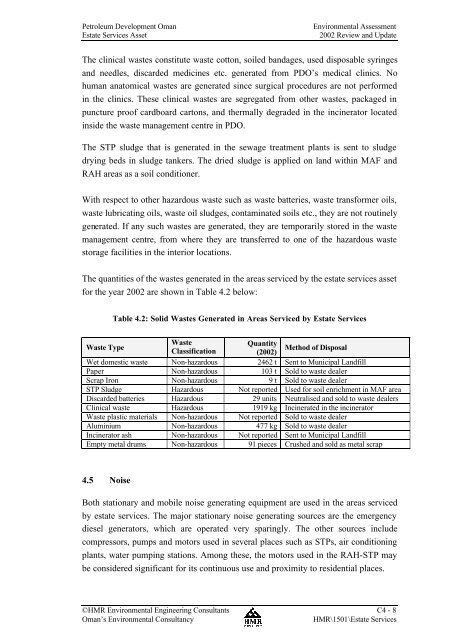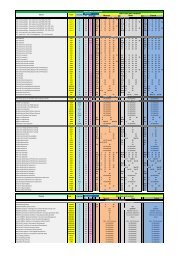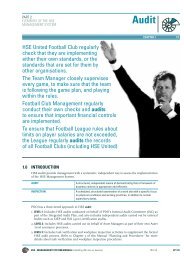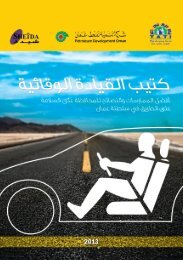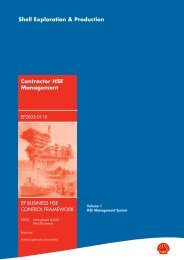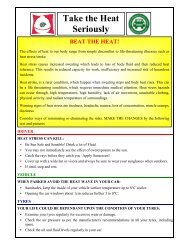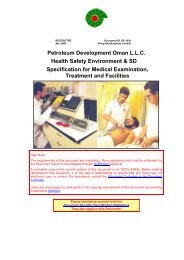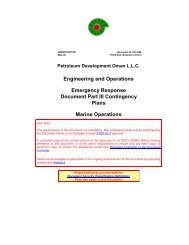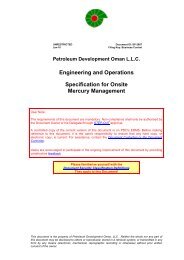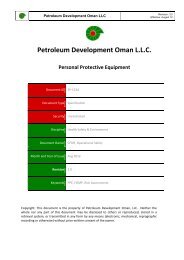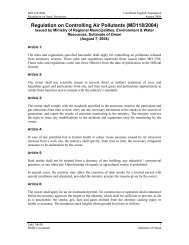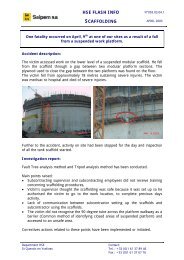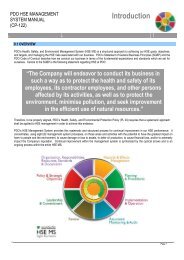Estate Service Asset - PDO
Estate Service Asset - PDO
Estate Service Asset - PDO
Create successful ePaper yourself
Turn your PDF publications into a flip-book with our unique Google optimized e-Paper software.
Petroleum Development Oman<br />
<strong>Estate</strong> <strong>Service</strong>s <strong>Asset</strong><br />
Environmental Assessment<br />
2002 Review and Update<br />
The clinical wastes constitute waste cotton, soiled bandages, used disposable syringes<br />
and needles, discarded medicines etc. generated from <strong>PDO</strong>’s medical clinics. No<br />
human anatomical wastes are generated since surgical procedures are not performed<br />
in the clinics. These clinical wastes are segregated from other wastes, packaged in<br />
puncture proof cardboard cartons, and thermally degraded in the incinerator located<br />
inside the waste management centre in <strong>PDO</strong>.<br />
The STP sludge that is generated in the sewage treatment plants is sent to sludge<br />
drying beds in sludge tankers. The dried sludge is applied on land within MAF and<br />
RAH areas as a soil conditioner.<br />
With respect to other hazardous waste such as waste batteries, waste transformer oils,<br />
waste lubricating oils, waste oil sludges, contaminated soils etc., they are not routinely<br />
generated. If any such wastes are generated, they are temporarily stored in the waste<br />
management centre, from where they are transferred to one of the hazardous waste<br />
storage facilities in the interior locations.<br />
The quantities of the wastes generated in the areas serviced by the estate services asset<br />
for the year 2002 are shown in Table 4.2 below:<br />
Table 4.2: Solid Wastes Generated in Areas <strong>Service</strong>d by <strong>Estate</strong> <strong>Service</strong>s<br />
Waste Type<br />
Waste<br />
Quantity<br />
Classification<br />
(2002)<br />
Method of Disposal<br />
Wet domestic waste Non-hazardous 2462 t Sent to Municipal Landfill<br />
Paper Non-hazardous 103 t Sold to waste dealer<br />
Scrap Iron Non-hazardous 9 t Sold to waste dealer<br />
STP Sludge Hazardous Not reported Used for soil enrichment in MAF area<br />
Discarded batteries Hazardous 29 units Neutralised and sold to waste dealers<br />
Clinical waste Hazardous 1919 kg Incinerated in the incinerator<br />
Waste plastic materials Non-hazardous Not reported Sold to waste dealer<br />
Aluminium Non-hazardous 477 kg Sold to waste dealer<br />
Incinerator ash Non-hazardous Not reported Sent to Municipal Landfill<br />
Empty metal drums Non-hazardous 91 pieces Crushed and sold as metal scrap<br />
4.5 Noise<br />
Both stationary and mobile noise generating equipment are used in the areas serviced<br />
by estate services. The major stationary noise generating sources are the emergency<br />
diesel generators, which are operated very sparingly. The other sources include<br />
compressors, pumps and motors used in several places such as STPs, air conditioning<br />
plants, water pumping stations. Among these, the motors used in the RAH-STP may<br />
be considered significant for its continuous use and proximity to residential places.<br />
©HMR Environmental Engineering Consultants C4 - 8<br />
Oman’s Environmental Consultancy<br />
HMR\1501\<strong>Estate</strong> <strong>Service</strong>s


